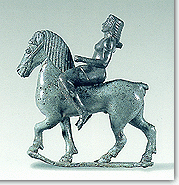





     | |
|
|
During the |  |
In Central Greece the workshops of Boeotia and Thessaly, did not manage to develop a style of their own although they never ceased to create. The provincial character of their works could not surpass the level of the simple imitation. On the contrary, in Macedonia, wher up to a few years ago it was impossible even to consider the existence of workshops of bronze sculpture, it seems all the more likely that a complex style flourished with mostly Ionian and Corinthian elements. The researches of recent years has brought to light many works, with the special characteristics that have already been observed in the "the squatting person of Edessa" and "Heracles of Amphipolis". However, this phenomenon is until today observed more often in the field of toreutics. |
The works from Magna Graecia and Sicily constitute a special chapter in bronze sculpture. In these areas Corinthian and Laconian works of toreutics, which influence the local workshops mainly exist. However, it is not imitation, since the Italian workshops include different elements in a way that characterizes the art of the west colonies. They have a special preference for ornaments, whereas they are indifferent about detail and accuracy. The anatomic lines are contrived and the proportions abide by the decorative character of these works. Cumae and Tarentum must have been important centres, where the Laconian influences are obvious as in the Locri Epizephyrii.
|
| |
|
Note: Click on picture for short description. | |